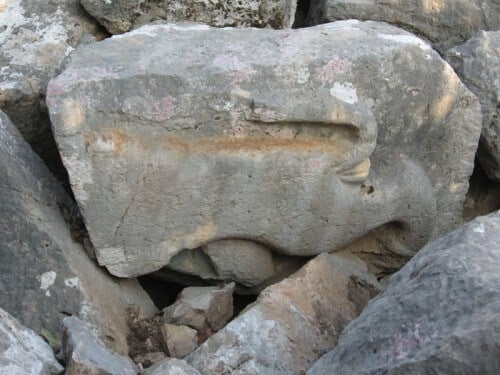The lion is the royal symbol of the Mamluk sultan Bibers who ruled between 1277-1260; Apparently, at least two more lions that have not yet been found are 'hiding' in the fort

The lion is the royal symbol of the Mamluk sultan Bibers who ruled between 1277-1260; Apparently, at least two more lions that have not yet been found are 'hiding' in the fort
A large relief of a lion was discovered last week in the Nimrod Fortress National Park. The lion relief was discovered after it caught the attention of one of the garden workers who noticed the lion's tail. The relief was built by the Mamluks over 700 years ago. The lion is the royal symbol of the Mamluk sultan Bibers (who ruled between 1277-1260).
The dimensions of the large stone bearing the relief are: 1.1 m long, 0.7 m high and 0.6 m wide. In the relief, the lion's parts are clearly visible except for the head, at the bottom of the relief the lion's testicles stand out, testifying to his memory. The back left leg is pulled back strongly and on it is a large bracelet indicating the belonging of the king of animals to the Muslim ruler. The abdomen protrudes in the form of a rising and falling wave and below it is visible the beginning of the broken right hind leg in its lower part. The stone was exposed for many years and a dark gray patina was formed on it.
On the left side, the stone is well carved diagonally, which leads to the conclusion that the lion was composed of two stones. On the missing stone was the front part of the lion: the head, the mane, the front body and the two front legs. On a fragment of this stone that was discovered right next to the large stone, there is the left front leg of the lion which is also carrying a large bracelet.
According to Dr. Tzvika Tzuk, Chief Archaeologist, Nature and Parks Authority: "The discovery of a lion relief of this size is an extremely rare find, therefore it is an important discovery that sheds light on the Nimrod fortress and the history of the area during the reign of the Crusaders and the Mamluks."
This relief is very similar to a perfect relief of a lion that was discovered in archaeological excavations on the western side of the fort about 15 years ago by Dr. Moshe Hertel, on behalf of the Antiquities Authority. This relief is on display at the western entrance to the fort. Comparing the dimensions between the two reliefs shows that the new relief is about 25% larger than the previous relief.
It seems that while the first relief was inside an inner tower, this relief was at the top of the outer wall on the east side of the fort and was intended to be seen from a great distance, so it is larger.
In two other sites located in Israel, Beavers' lions are recognized as appearing in pairs standing opposite each other as found at the Blood Bridge - one pair and at the Lions' Gate in Jerusalem 2 pairs, but it is possible that the lions were not necessarily arranged regularly in pairs.
Since these two lions turn to the left, it can be assumed that there are at least two more lions 'hiding' in the fort whose gaze is turned to the right. Other examples where the lion turns to the left are from the citadel in Safed and on a gold coin belonging to Beavers.
Beavers was one of the most important Mamluk sultans and excelled in 3 victories over the Crusaders and 1260 victory over the Mongols in the battle of Ain Jalud (XNUMX). The translation of his name Bey = lord of bears = tiger also indicates the animal which is his heraldic symbol. The animals that appear elsewhere on reliefs are schematic and do not allow a clear identification of the animal, but in the Nimrod fortress the reliefs are more realistic (except for the head) and allow them to be identified as lions.
Sultan Beavers also excelled in many construction projects: forts, bridges, the shakim factories, ports, mosques and more.
Based on a press release from the Nature and Parks Authority

4 תגובות
A person
His tail on the right side of the stone, curves up and forward. The horizontal brown stripe is on the lion's back.
Indeed, a lot of imagination is needed...
crushed The fertile imagination of archaeologists
A person
1: He hides inside the stone.
2: I do not recommend you to participate in the television show Moon Time
I couldn't spot a lion in the picture